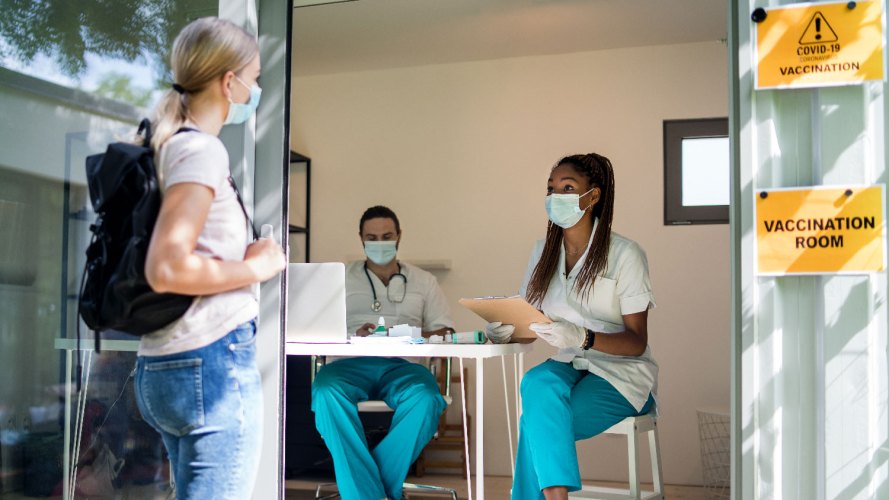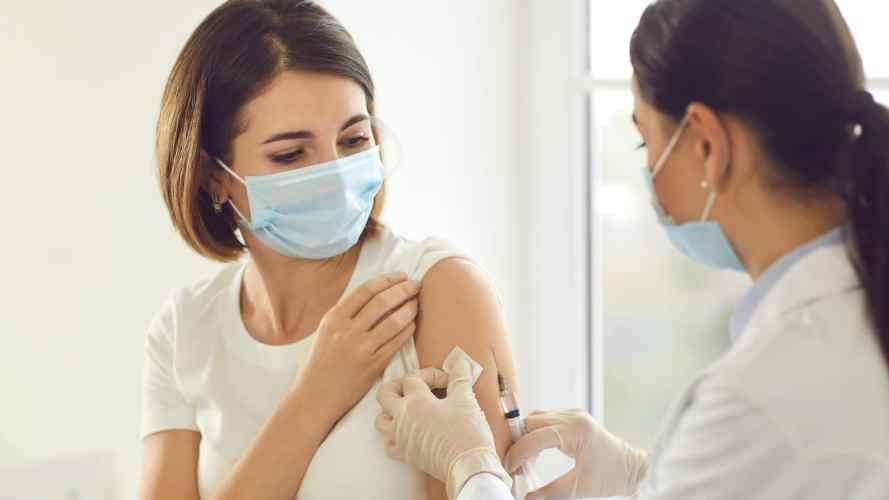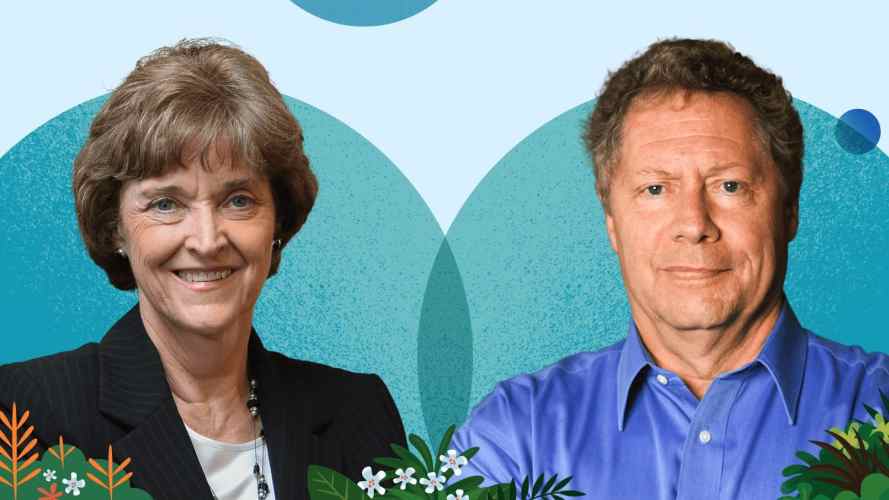Vaccines Are Here but Uncertainty Remains — What Business Leaders Need To Consider Now



Every country is in a race to contain the spread of COVID-19 and its variants, while vaccinating as much of their populations as fast as possible. We explore the range of possibilities.

Noah Rimland Flower
Peter Schwartz and Mick Costigan contributed to this article.
On January 26, the world surpassed 100 million confirmed cases of COVID-19, a number that seemed unfathomable a year ago. Now, with several vaccines approved for use worldwide, every country is in a race to contain the spread of COVID-19 — including worrying new strains — and to vaccinate their populations as fast as possible.
Since last March, we’ve developed a series of scenarios to help answer the question of how the crisis might evolve. When we began, plausible possibilities ranged from a brief six-month blip, as happened with SARS, to a 5+ year calamity that could entirely restructure the global order. Salesforce Chief Futures Officer Peter Schwartz noted in our first COVID-19 scenarios that he had never experienced greater uncertainty in his nearly 50 years of working in scenario planning.
By mid-November, thanks to historic achievements in vaccine development, the range of uncertainty had narrowed. Effective vaccines promised a quick end to the crisis, perhaps as early as the spring in rich countries. Many business leaders breathed a sigh of relief.
We noted then that many downside possibilities remained, and indeed, in just two short months, the situation has evolved dramatically. While millions have received the first dose of the vaccine, vaccination production and delivery have been unexpectedly sluggish. Across the world, only Israel appears to be on track for that original spring timeline for a vaccination-driven exit of the pandemic.
Most importantly, the virus itself is changing. New strains are more transmissible, virulent, and resistant to vaccination. One strain is even showing signs of all three. The more transmissible strains, in particular, threaten to produce a new surge in cases, as we’ve already seen in the U.K., deepening the pandemic even as vaccination ramps up. Further, it is not yet clear how protective current vaccines and antibodies will be. Moderna is already creating an updated booster shot, and other adjustments will likely be required over time.
A new set of uncertainties
These developments suggest a new framework for understanding the race between vaccines and a virus that is gaining speed. We believe four critical uncertainties frame the pandemic possibilities over the next year and beyond. Two are virus-related: when will the virus be brought under control, and how long will it take to reach herd immunity? Two are economic: what will the depth and duration of the downturn be, and once the economy has reached precrisis levels of output, how robust will the return to growth be? We’ll start with the virus.
Uncertainty #1: When will the infection be brought under control?
Since March, variation in countries’ ability to control COVID-19 has led to two basic outcomes. First, a small group of countries, mainly in eastern Asia along with Australia and New Zealand, mastered nonpharmaceutical interventions such as lockdowns, masking, distancing, travel restrictions, and contact tracing to comprehensively control the virus. Most of the rest of the world has struggled to maintain any meaningful control, with only drastic lockdowns providing temporary case reductions. The new strains are now driving more surges in countries that already struggled, and even those with a strong track record are experiencing outbreaks.
As new strains proliferate, the ability to suppress the virus through nonpharmaceutical interventions will be crucial. Governmental competence plays a crucial role, but individual behaviors also matter. Greater fear of new variants might drive a heightened degree of discipline. Tighter lockdowns are already being imposed in many parts of the world, but COVID fatigue may reduce their effectiveness.
Uncertainty #2: When will we reach herd immunity?
Viruses stop spreading when there aren’t enough people available to infect, which is called herd immunity. For most of the crisis, the consensus view of that herd immunity target among epidemiologists was 60-70%. But new strains that transmit more easily raise the target. The updated view from Dr. Anthony Fauci, director of the National Institute of Allergy and Infectious Diseases, is that 70-90% may be required. Dense urban centers, like New York, might need an even higher number, while rural areas might be safe at a lower level.
For countries like the U.S., where between 17% and 39% of the population has already been infected, the good news is infection-acquired immunity will last at least six to eight months. And while infections continue to rise, the number of people with infection-acquired immunity will grow substantially.
If 90% is the target, and 30% of the population acquires immunity through infection, vaccination must reach at least another 60% of the population. Otherwise, the spread will only slow, not stop.
When we unpack this uncertainty, there are three important sub-questions to track:
1. Supply
Currently, vaccine nationalism has taken hold, with only the U.S., U.K., Canada, Australia, EU, and Japan having secured sufficient doses, while much of South America and Latin America are expected to wait until 2024, largely because wealthier countries have secured most of the available supply. And even though the EU has an agreement with AstraZeneca and Pfizer to buy vaccines, production has run short. This is the reason why the World Health Organization’s chief scientist has warned that herd immunity at a global level is highly unlikely this year. Further, the Economist Intelligence Unit projects that most industrialized economies will complete vaccination towards the end of the year. That timeline is likely to accelerate as more vaccines are approved, but how fast?
2. Capacity to deliver
In the U.S., achieving just 70% immunity by July 4 would require distributing an average of 2.4 million doses per day, far higher than the Biden Administration’s goal of 1.5 million per day. At a slightly slower rate of 1.2 million per day, 70% immunity would not be achieved until the end of the year.
Vaccine management playbook
Learn how to efficiently manage vaccines in your community.



Technology can play a key role in streamlining distribution and administration. Salesforce Vaccine Cloud, for example, helps government agencies, healthcare organizations, businesses, nonprofits, and educational institutions more rapidly, safely, and efficiently manage vaccine programs. However there is still room for improvement around equitable delivery, as distribution in communities of color and low-income communities is lagging.
3. Demand
The final hurdle to overcome is vaccine hesitancy. For many understandable reasons, just 64% of the world intends to take the vaccine within the coming year, as of November, and only 33% want it as soon as possible. February figures for the U.S. are slightly higher, showing 77% interest. Some of that hesitancy is likely to melt away if the public impression of vaccination is that it is safe, but some of it will intensify due to rumors, poor reporting, and misinformation portraying the vaccine as risky.
This is an area where business leaders can play a productive role. If businesses not only organize vaccination of their employees but also put serious effort into convincing employees that vaccines are safe and herd immunity is critical, it could put a sizable dent in the problem. Indeed, businesses are now considered the most trusted source of information among four institutions studied by Edelman, and the only institution seen as both ethical and competent.
Uncertainties #3 and #4: What is the duration and depth of the downturn, and how robust is the return to growth?
Moving from the virus to its follow-on effects, this second pair of uncertainties are about the economy and society. As of December, the Organization for Economic Cooperation and Development’s (OECD) forecast of global growth was for a return to the precrisis baseline in Q3. In early February, the U.S. Congressional Budget Office (CBO) released similar projections. However, these forecasts predate the understanding of the new variants, the response of strict new lockdowns, and a decline in confidence. Outside of COVID-free economies that were already rebounding, a new surge would deepen and prolong the downturn.
Those rosier estimates provide a useful upper estimate on how quickly the economy might bounce back. The lower bound would be determined by how much the economy shuts down in the face of new variants and a slow path to herd immunity.
Two other questions to watch are: the degree of consumer confidence, and fiscal and monetary stimulus provided by the government. As normalcy gradually returns, many predict a boom in consumer spending, given that U.S. consumers alone saved $1.4 trillion in the first three quarters of 2020. Even if the new variants create major economic hardship, another round of strong fiscal support like the $1.9 trillion stimulus proposed by President Biden would blunt the worst effects.
The current baseline scenario: A midyear recovery
Using the U.S. as an example of many industrialized economies where the virus remains out of control, our baseline scenario is for infections to rise substantially in the winter, plateauing in the spring as mobility drops in the face of new variants, tight lockdown policies, and public fears. Infections would then drop quickly over the summer, as vaccination approaches herd immunity.
Economically, our baseline is to be more conservative than the CBO and OECD, tempering their optimism with the expectation that fear of infection will significantly constrain economic activity through the spring. Our expectation is for growth to return at a fast clip in the second half of 2021, and for precrisis gross domestic product (GDP) to be achieved by the end of the year. In 2022 we project continued growth, but at a slower rate once the initial burst of euphoria fades and as the uneven global economy continues to subdue international trade, travel, and overall confidence.
By contrast, we expect to see continued competence at managing the virus among eastern Asian nations, Australia, and New Zealand. Their baseline is to maintain control, even in the face of new variants, and for vaccination to ramp up quickly. Since so few of their population have been infected, herd immunity will be totally dependent on vaccines and arrive on a similar timeline to the other group of rich countries. We expect their growth to continue at a moderate pace through the end of the year, then accelerate as the rest of the industrialized world enters a new normal.
What could take us away from baseline?
There are many ways our baseline could fall apart. We could see vaccines prove less effective in the real world than they appeared in trials, with new strains playing a role. Thanks to new messenger RNA (mRNA) technology, additional new vaccines could be developed quickly, but design and production might set back timelines. Public frustration with endless cycles of lockdown could lead to lack of trust in public health authorities, resulting in reduced compliance on masking and distancing. We could also see frightening stories about vaccines proliferate on social media, causing vaccine hesitancy to grow high enough that herd immunity is never achieved. With the virus only partially contained, a return to pre-COVID-19 norms would be reliant on breakthroughs in testing to make offices and restaurants safe again. But if technology did not deliver, we could be stuck with a heavy drag on productivity and spending for several years.
A brighter world is also possible. We could be lucky with the variants: they could turn out to have flaws that the early data has not revealed, or the faster-spreading variant first spotted in the U.K. could outcompete those from South Africa and Brazil that have stronger defenses against vaccines. We could also be lucky with vaccines: a host of new entrants could be approved, including several that are easy to distribute in the developing world, raising the level of supply such that nearly every country can secure sufficient doses by the end of next year. We could be ingenious in our engineering: new at-home testing could emerge that is fast, cheap enough to use daily, and highly accurate.
We could be smart in our individual response: the specter of a more fearsome virus and the hope of ending the crisis will hopefully inspire a wave of adherence to masking and distancing, cutting the death toll. We could be unified in our push to vaccinate: top business, government, and cultural figures could visibly link arms and inspire the public to achieve herd immunity together.
Finally, we could be smart in our policy response: governments could make aggressive investments to support those most affected and accelerate entrepreneurship and retraining in growth sectors, putting their economies on a stronger footing than ever before.
Business leaders must remain alert, agile, and outspoken
Nearly a year into the crisis, anyone could be forgiven for feeling a sense of fatigue with tracking the daily developments. This is the time for business leaders to stay the course. Three traits are essential in what will hopefully be the final months of this trying time:
- Alert to the earliest indications that the crisis is taking a turn for the better or the worse in the countries where the enterprise is active, in the ways outlined above.
- Agile in the face of those changes, particularly with regard to reopening timelines, vaccination programs, and choosing when to make investments that will pay off when the new normal emerges.
- Outspoken to employees, customers, and partners on the importance of staying safe in the face of the new variants, the safety of vaccines, and the critical importance of achieving herd immunity.
We remain in a moment of historic change. By watching carefully, we can all spot the opportunities to nudge our collective course in the best possible direction.
























